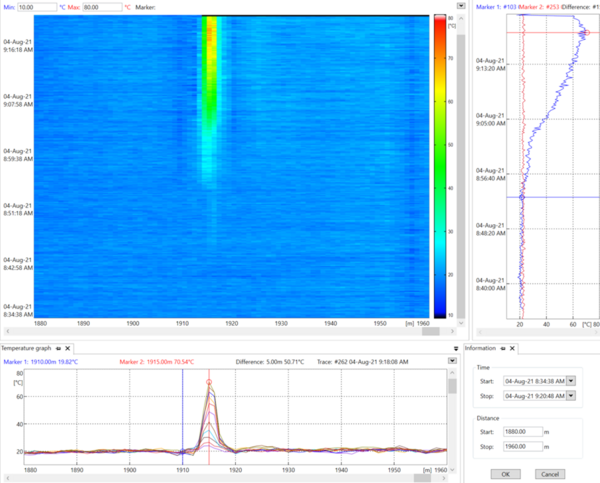AP Sensing recently conducted trackside fire trials with the German rail operator, Deutsche Bahn! The trials took place approximately 45 km outside of Berlin in Michendorf, Germany, and were carried out by the local fire department. Experimenting with various types of fire accelerants in a cable duct, the tests were administered to test the response times and early detection capabilities of our Distributed Temperature Sensing (DTS) N45-Series system .
One N4525, single mode DTS device was used for the trials. The tests were conducted near operational rail tracks in a cable trough that contained copper cables, telecommunication cables and fiber optic cables, all critical to rail operations. Four different experiments took place using different fire accelerants in order to test the ability of our DTS technology to monitor developing hotspots in cable ducts – specifically, to detect and localize fire incidents at an early stage, leading to quick alarming and the ability to respond rapidly with countermeasures. AP Sensing’s SmartVision software was also used for recording, visualizing, and analyzing the data.
Fire Tests
The test results were incredibly successful, with all tests generating a significant temperature signal that could be measured and precisely localized throughout the development of the fires. These hotspots and developing fires quickly and successfully alarmed on both the DTS device and in our SmartVision software . The execution of these fire tests and real time processing of the data and alarms proved that DTS technology can play an important role in early fire detection in cable troughs.
Detection Capabilities
In the event of a fire, transmitting important information to the fire alarm control panel (FACP) or responsible control center is an essential feature of a fire detection system. With short measuring times and sophisticated performance, AP Sensing’s fiber optic technology provides fast and reliable alarming, which limits the extent of fire damage and the associated costs and safety risks posed by a fire. The system accounts for the fire signature and maximum temperature, enabling system operators to make a quick first decision about deploying the fire brigade. In addition, in the case of arson, system time stamps and the software-based temperature history can be combined with other existing sensor systems such as surveillance cameras for perpetrator tracking.




